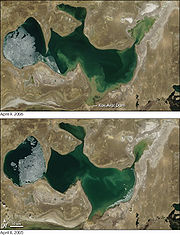
Dike Kokaral
Encyclopedia

Levee
A levee, levée, dike , embankment, floodbank or stopbank is an elongated naturally occurring ridge or artificially constructed fill or wall, which regulates water levels...
across a narrow stretch of the Aral Sea
Aral Sea
The Aral Sea was a lake that lay between Kazakhstan in the north and Karakalpakstan, an autonomous region of Uzbekistan, in the south...
, splitting off the North Aral Sea
North Aral Sea
The North Aral Sea is the portion of the former Aral Sea that is fed by the Syr Darya River. It split from the South Aral Sea in 1986 as water levels dropped due to river diversion for agriculture. The poorly built Dike Kokaral intended to contain the North Aral Sea and save its fisheries failed...
(also called "The Small Sea") from the much larger South Aral Sea
South Aral Sea
The South Aral Sea is a lake in the basin of the former Aral Sea which formed in 1986 when that body divided in two, due to diversion of river inflow for agriculture...
("The Large Sea"). Work was completed in August 2005.
Water level of the North Aral has risen, and its salinity has decreased. As of 2006, some recovery of sea level has been recorded, sooner than expected. "The dam has caused the small Aral's sea level to rise swiftly to 38m (125ft), from a low of less than 30m (98ft), with 42m (138ft) considered the level of viability." Economically significant stocks of fish have returned, and observers who had written off the North Aral Sea as an environmental catastrophe were surprised by unexpected reports that in 2006 its returning waters already were partly reviving the fishing industry and producing a catch for export as far as Ukraine. The restoration reportedly gave rise to long absent rain clouds and possible microclimate changes, bringing tentative hope to an agricultural sector swallowed by a regional dustbowl, and some expansion of the shrunken sea. "The sea, which had receded almost 100 kilometres (62.1 mi) south of the port-city of Aralsk, is now a mere 25 kilometres (15.5 mi) away."
The dike is conserving the dwindling waters of the Syr Darya
Syr Darya
The Syr Darya , also transliterated Syrdarya or Sirdaryo, is a river in Central Asia, sometimes known as the Jaxartes or Yaxartes from its Ancient Greek name . The Greek name is derived from Old Persian, Yakhsha Arta , a reference to the color of the river's water...
river and maintain (and attempt to revive) the damaged ecology of the North Aral Sea, at the expense of sealing the fate of the larger South Aral. As the waters of the contributory rivers to the Aral have been progressively redirected for irrigation, the water levels in the Aral have fallen, the shore receded, and the water quality has dropped precipitously.
Dike Kokaral is named after the Kokaral
Kokaral
Kokaral was until 1973 an island in Kazakhstan, in the northern part of the Aral Sea. It had an area of 273 km² , and its highest point was the 163 meter high hill called Daut...
peninsula (an island until the 1960s), which would connect it to the other shore of the Aral Sea and separate the northern from the southern seas. The dike was built twice in the past from local sand, but due to a lack of funding necessary to strengthen it once the water level in the North Aral Sea (and therefore pressure to the dike) began to rise, the dike was washed away. This happened in 1992 and 1998. However, for the short time that the dike stood, positive changes were already noticed - the climate became milder, and fauna was partly restored. When the dike was washed away, the water-level fell again, as much of the water poured into the South Aral Sea. In some places the coastline of North Aral retreated by as much as a few hundred meters.

